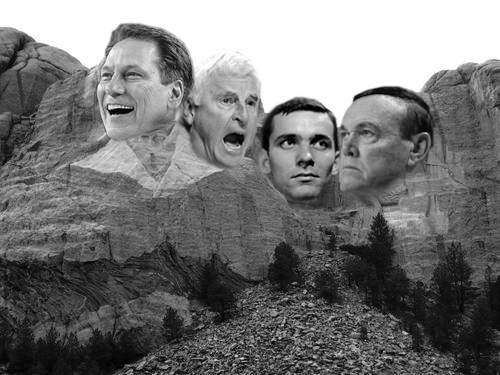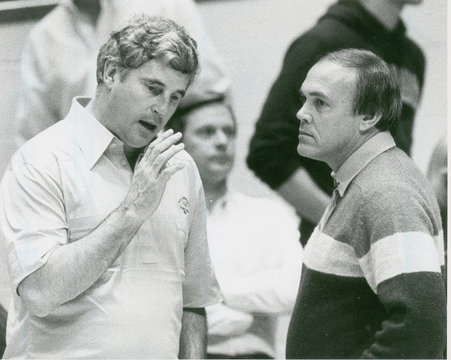Big Ten Mount Rushmore
Posted by Deepak Jayanti on February 21st, 2012When the Big Ten recently added Nebraska and thus broke into two six-team football divisions, fans and pundits alike broke out in disdain over the “Legends” and “Leaders” distinctions. But while every conference has its legends, the Big Ten’s leaders are the men who rise to the top and would adorn its Mount Rushmore…
The man they called “The General,” as fierce and unique a competitor and coach the game has ever seen. One of the greatest student-athletes (Jerry Lucas) in the history of college sports, and another coach who lives for the month of March every single season (Tom Izzo). We only wish we could take credit for the Wizard of Westwood, as the legendary John Wooden — you could mold a Mount Rushmore consisting of Wooden’s students alone — spent his playing days at Purdue. Alas, we think we’ve got a pretty good group without him.
Bob Knight
There are very few coaches in all of basketball at any level that demand the complete respect of the players and Bobby Knight is one of them. Basketball in the state of Indiana has been well-documented for decades but Knight took it to a different level during his tenure in Bloomington. Every father in Indiana hoped for his son to play for the IU coach because of what he meant for the state and the game. Three National Championships over his tenure are just the tip of his accomplishments. What meant more to the state and rest of the Big Ten was how he went about his business. He had an incredible graduation rate with his players and they played the tough-nosed basketball that has been a staple of the Big Ten brand for decades now. In addition to his championships, he is the last coach to lead a team to a perfect season (1975-76) and also added a couple more Final Fours to his name. His knowledge of the game is a treasure to all of college hoops and there was no better representative of the Big Ten’s message at the national stage than Knight. He dominated Big Ten conference play as his teams won 11 regular season championships during his tenure, and, did we mention that he graduated from Ohio State? He is a true Big Ten icon.
Jerry Lucas
The Ohio State University is known for their football legends – Woody Hayes and Archie Griffin just to name two of them. But Jerry Lucas left Columbus as the second most influential Buckeye upon graduation in the early 1960s, right behind Jesse Owens. Lucas’ individual accomplishments include being named the Big Ten MVP three times and as a first team All-America for three years. He led his team to three NCAA final games including one championship. He was as good as Oscar Robertson during his college career and he topped it off with an Olympic gold medal in 1960. He dominated the game during his era and was a great ambassador for Big Ten basketball.
Gene Keady
Bobby Knight needed a rival to push himself further and Gene Keady was more than just a competitor. Even though Keady didn’t succeed at the national level as much as Knight, he refused to back down during conference season. Purdue won six conference championships during his time in West Lafayette, but more importantly, Keady’s teams trademarked the bruising brand of basketball in the conference. He remains second in terms of winning percentage within the conference right behind Knight. Keady’s contributions to the game can’t just be measured only using his record because he was the teacher of all teachers. The Keady coaching tree is vast and has added incredible value to the college game – Matt Painter, Bruce Weber and Steve Lavin are just a few of his assistants who have moved on to coach at major programs and carry on his legacy. He didn’t always recruit the greatest athletic talent but he knew how to maximize it because he believed in developing toughness and the character of his players. Mackey Arena became one of the toughest and most rugged home courts to play at during his time on the bench. Opposing coaches learned to never underestimate his teams because he turned less athletic players such as Brian Cardinal into menaces on the court. Several coaches in the Big Ten such as Tom Izzo and Bo Ryan look up to Gene Keady because they believe in building teams, not just recruiting the best athletic talent. B1G basketball has great coaches who teach the game like no other and there was nobody better at doing so than Keady in this conference. Every expert describes Big Ten basketball as gritty and hard-nosed, adjectives used to describe a football game. Gene Keady deserves most of the credit for that style of play. Together with Knight, they raised Big Ten basketball to new heights during the ‘80s and ‘90s.
Tom Izzo
If Knight and Keady kept the Big Ten alive from roughly 1980 to 2000, Izzo has carried that torch since then. Even though the traditional programs such as Indiana and Purdue went through a rebuilding phase in the 2000s, Izzo single-handedly kept the conference relevant in March by leading Michigan State to six Final Fours during his tenure in East Lansing. Izzo marked his name into Big Ten history during the late ’90s when he led the Spartans to three straight Final Fours along with a title with the famous “Flintstones” team. He breathes toughness into his team and his game planning during the postseason is impeccable. Izzo never shies from the spotlight and is known to play the toughest schedule during the non-conference portion of the season because he prepares to win the championship. He cares about Final Fours and has shown no signs of slowing down.
Honorable mentions (in no particular order)
Earvin “Magic” Johnson: Jud Heathcote knew the tall lanky point guard as Earvin before the nickname “Magic” became famous. Forget putting Michigan State basketball on the map, Johnson is credited for helping to put college basketball on the map. He was a sight to see in running the Spartans to the 1979 National Championship against the great Larry Bird, and went on to become one of the most endearing figures in the sport of basketball. Magic was the first point guard of his kind — at 6’9″, he averaged more than 17 points, seven rebounds and seven assists per game for his career — and we’re unlikely to ever see one like him again. To this day, that 1979 title game remains the most watched college championship game of all time. Johnson remains a great ambassador for Michigan State and the Big Ten on the national stage because he bleeds green despite being away from the state of Michigan for over thirty years.
Calbert Cheaney: If you’re not a die-hard college hoops fan, or a member of the Hoosier faithful, Cheaney’s name is not the most recognizable name in the history books. But he’s a no-brainer for this list. The Big Ten’s all-time leading scorer with 2,613 points, Cheaney was a three-time All-America and averaged 19.8 points per game over the course of his four-year career. The only knock on him is that he never led the Hoosiers to a national title but he signified all the characteristics that Bobby Knight strived to instill into the university and the conference. What separated his true grit as a college player was his willingness to play tough defense against the best wings around despite all of his offensive accolades. In a day and age where few players take pride in their game on both ends of the court, he remains an example of the Big Ten brand of basketball that has lived on for decades.
Steve Alford: Unlike Cheaney, Alford — No. 5 on the Big Ten’s all-time scoring list with 2,438 career points — was able to secure a title in his time at Indiana (1987). Alford is another “Bob Knight Warrior” because he embraced Knight’s philosophy during his time in Indiana. He was known to be one of the greatest three-point shooters in the history of the conference and improved his game consistently over his college career.
The Fab Five: These Wolverines were certainly leaders of a different kind, helping to usher in a new era to college basketball, but nearly all of their accomplishments have been vacated due to NCAA violations.
Glen Rice: A great scorer — third all-time in the Big Ten for career scoring — who led the Wolverines to the 1989 title by averaging over 30 PPG in the six games.
Jim Jackson: A three-year starter at Ohio State who was the NPOY in 1991, Jackson was one of the best wings to ever play in the conference. He averaged 16.1 points per game and shot close to 50% from the field during his time in Columbus.
Other Mount Rushmores:
Feel free to leave your comments as to what you think below.














































[…] be one), who would be four faces of the conference? One of the TYS writers takes a crack at it in this article. Share this:TwitterFacebookLike this:LikeBe the first to like this […]
Well done!